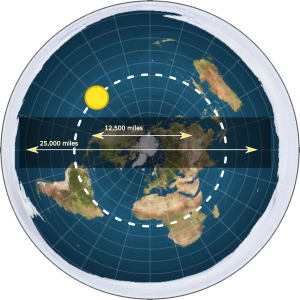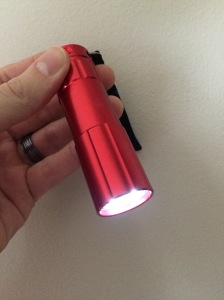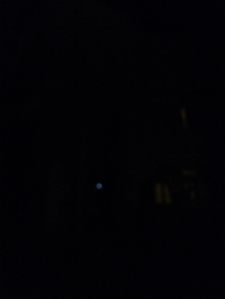Some of you may be surprised to hear that there are still people who believe the earth is flat, rather than a sphere. If you search for “flat earth map” or “flat earth disc,” you will see that Earth is actually shaped more like a thick plate than a ball. Now, I am sure this school of thought is made up of at least as many trolls and comedians as there are genuine adherents, but that doesn’t diminish the fun of thinking through the how’s and why’s of a Truman or Matrix world, where reality is not quite what it seems. And sure, there are plenty of articles and YouTube videos debunking various aspects of the theory, but there was one point I was curious to explore on my own: the Sun.
According to Flat Earth Wiki, the sun is 32 miles in diameter and 3,000 miles away from the surface of a flat Earth, as opposed to 432,288 miles across and nearly 93 million miles from a spherical Earth. This same reference, along with many others, reveal that day and night are the result of a spotlight effect, created by the Sun circling around the Equator, shining light on one part of the map in the day and another part at night. The question that came to mind for me, and I have yet to see addressed from either side, is this: “If the Sun were circling above a flat Earth, wouldn’t we be able to see it in the distance even if it were on the other side of the planet?”

Map of Flat Earth retrieved from http://www.theflatearthsociety.org/home/application/files/4514/6118/3813/Flat_earth.png (Notations, etc. added by me)
On a sunny day, clouds would not obstruct our view, but perhaps obstacles such as mountains could hide the Sun from us. Well, I set out to discover the answer to my questions, which meant it was time for an experiment. My plan was simple: find a small flashlight, measure its diameter, and setup an area to scale that would represent the distance from Equator to Equator on opposite sides of the Earth. Then, my beautiful assistant (AKA my wife) would suspend the light pointing straight downward over the Equator on one end, and place an observer looking up from the ground on the other. In this case, the observer would be an upside-down iPhone camera to get as close to the ground as I could. Here are the measurements I used:
| Property | Full size measurements | Scaled |
|---|---|---|
| Diameter of the Sun | 32 miles | 2.5 centimeters |
| Distance to the Sun | 3,000 miles | 7.689 feet |
| Diameter of the Equator | 12,500 miles | 32.039 feet |
| Highest Point of Mt. Everest | 29,035 feet | .169 inches |
(The radius of the Equator can be found on the Flat Earth Society Wiki. Note that I set the light a little lower and further away, which would theoretically work in the flat Earth theory’s favor.)
And here is a rough diagram of the experiment’s setup:
You will note that there is an obstacle more than twice the height of Mount Everest intentionally blocking the observer. This is because 1.) I wanted to try and view the Sun from the worst possible location, and 2.) I was having trouble finding something that was exactly .169 inches tall to act as Mount Everest. As a side note, it’s really cool to start picturing geographic landmarks on this scale. Anyway, this setup should give us an idea of what we would see if we were standing in the shadow of a giant mountain on the Equator in the middle of the night, looking north across the Earth.
I had a few ideas of what to expect. Maybe the obstacle would block the observer’s view of the Sun. Perhaps the light would be so small and dim at this distance that it would not be visible. Maybe I would at least see the beam of light directing downward from the flashlight. With all these questions rolling around, I turned off the lights in the house, set the iPhone in its location, angled up toward the sky, and snapped a picture. Here is what I saw:
That pale little circle in the bottom half of the photo? Yeah, that’s the flashlight… Or, the Sun, rather. I don’t know enough about optics and light to explain why the downward-facing spotlight produced a circular image, but I do know the light was facing straight down. I was actually pretty amazed. The photo almost has an outer space beauty to it.
So, what does this tell us? Well, only so much. This wasn’t performed in a controlled environment with unbiased witnesses, and the measurements aren’t perfect. But, I think this demonstrates that the Sun is simply too “high” and large (and not to mention far more intense than this little flashlight), whether you accept a flat Earth or a spherical Earth, not to be seen from one side of the planet to the other if it were simply rotating around a flat surface. I am quite confident you could push that light much further back and even lower and it would still be visible from the opposite side of the Equator. Don’t believe me? Give it a try. I created this calculator with jscalc.io to help scale your setup.
There are of course many other aspects of the flat Earth theory, but plenty of people on both sides of the argument have already gone into great detail on those. This experiment was more about having fun and putting an idea to the test. I’m not really interested in a flat Earth debate, but I am curious to hear ideas for an improved experiment, other more technical explanations of my observations, or your own observations. Have a thought or idea, please share!


